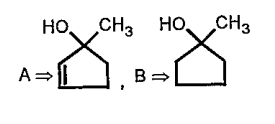An optically active alcohol A(C6H10O) absorbs two mole of hydrogen molecule per mole of A upon catalytic hydrogenation and gives a product B.The compound B is resistant to oxidation by CrO3 and does not show any optical activity . Deduce the structure of A and B.Solution in Bengali
Topper's Solved these Questions
Similar Questions
Which has higher conductance and why? Silver wire at 30∘C or silver wire at 50∘C?
View SolutionWhat is racemic mixture?
View SolutionAn optically active alcohol A (C_(6)H_(10)O) absorbs 2 mol of hydrogen per mole of A upon catalytic hydrogenation and gives a product B. The compound B is resistant to oxidation by CrO_(3) and does not show any optical activity Deduce the structures of A and B.
View SolutionGive the structure of an optically active alkene (A) having the lowest molecular mass, which on catalytic hydrogenation gives an optically inactive compound (B) .
View SolutionAn optically active compound A with molecular formula C6H14 undergoes catalytic hydrogenation to give an optically inactive product. Which of the following structures for A is/are consistent with all the data?
View SolutionAn optically active compound A with molecular formula C8H14 undergoes catalytic hydrogenation togive meso compound, the structure of (A) is:
View SolutionWhich of the following alkenes can generate optically active compounds upon hydrogenation ?
View SolutionC(C6H12), and optically active dydrocarbon which on catalytic hydrogenation gives an optically inactive compound, C6H14.
View Solutionएक प्रकाशिक सक्रिय ऐल्कोहॉल A(C6H10O) का प्रत्येक मोल, उत्प्रेरित हाइड्रोजनीकरण पर हाइड्रोजन के दो मोलों को अवशोषित करके एक उत्पाद 'B' देता है| यौगिक 'B', CrO3 के द्वारा ऑक्सीकरण का प्रतिरोध करता है तथा कोई प्रकाशिक सक्रियता प्रदर्शित नहीं करता है| A तथा B की संरचनाएँ ज्ञात कीजिए |
View SolutionAn organic compound with molecular formula C_5H_5Cl exists in two optically active forms A and B . A on hydrogenation in presence of a catalyst gives an optically inactive compound (C). While B gives an optically active compound D. The structure of A is
View SolutionAn optically active alcohol A (C_(6)H_(10)O) absorbs 2 mol of hydrogen per mole of A upon catalytic hydrogenation and gives a product B. The compound B is resistant to oxidation by CrO_(3) and does not show any optical activity Deduce the structures of A and B.
View SolutionGive the structure of an optically active alkene (A) having the lowest molecular mass, which on catalytic hydrogenation gives an optically inactive compound (B).
View SolutionAn optically active alcohol A(C6H10O) absorbs two mole of hydrogen molecule per mole of A upon catalytic hydrogenation and gives a product B.The compound B is resistant to oxidation by CrO3 and does not show any optical activity . Deduce the structure of A and B.
View SolutionGive the structure of an optically active hydrocarbon ( C6H12) which on catalytic hydrogenation gives an optically inactive compound ( C6H14)
View SolutionAn optically active alcohol (A)[C₆H₁₀O] absorbs two moles of hydrogen per mole of (A) upon catalytic hydrogenation and gives a product (B). The compound (B) is resistant to oxidation by CrO₃ and does not show any optical áctivity. Deduce the structures of A and B
View Solution

